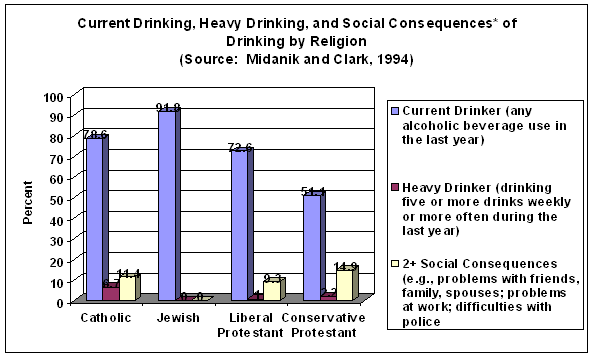Theories of Deviant Drinking
2. Macro-Normative: Norm Qualities Theory
Religion and Cultural Norms toward Alcohol Use
The norm qualities explanation of deviant drinking is based on a long tradition of macro-level research on the relationship between rates of alcohol use and drinking problems and religious affiliation in the U.S. The contrasting drinking patterns of two particular groups in North America—Jews and conservative Protestants—have received special attention because of their paradoxical nature. On the one hand, Jewish drinking patterns are noteworthy for (a) the relatively high prevalence of alcohol use among adolescents and adults and (b) the markedly low prevalence of alcohol-related problems among Jewish drinkers. This distinctive pattern suggests that something in their cultural norms about drinking protects Jews from the risks of early and widespread exposure to alcohol.
On the other hand, conservative Protestant groups, such as Southern Baptists or Mormons (Latter Day Saints), are well-known for a culture that discourages any alcohol use. In fact, members of conservative Protestant churches are more likely than other Protestants to be life-long abstainers from alcohol. Yet, when people who were raised in these fundamentalist religious groups do drink, some evidence indicates that they are significantly more likely than Jews or more liberal Protestants to experience drinking problems. Thus, this side of the religious paradox suggests that prohibitionist cultures and policies may, ironically, promote uncontrolled and troublesome drinking among those do, for whatever reason, use alcohol.

A well-designed national survey of U.S. drinking patterns conducted by Midanik and Clark (American Journal of Public Health, 1994) provides some interesting evidence on these and other religious differences in alcohol use and drinking problems. Interviews were conducted in 1990 with a sample of over 2,000 respondents who were representative of the U.S. adult population aged 18 years and over. The interview instrument included a number of measures of alcohol use and drinking problems, including items dealing with "social consequences" of drinking such as interpersonal problems with friends, family, or spouses and problems at work or with the police. The graph on the right reports some of Midanik and Clark's key findings about religious differences in (1) current alcohol use, (2) heavy drinking, and (3) social consequences of drinking.
The results for Jewish respondents are remarkable. Whereas over 90 percent of this group are current drinkers, none of them met the criteria for heavy drinking (i.e., five or more drinks weekly or more often during the past year). Furthermore, none of the Jewish respondents experienced two or more social consequences from drinking. Thus, alcohol problems appear to be virtually non-existent among Jewish drinkers. Some sociologists have described Jewish drinking culture as being "prescriptive" in nature, in that Jews learn a variety of rules and practices about alcohol, mostly wine, from an early age. These shared prescriptive understandings about alcohol provide Jewish drinkers with clear guidelines and limits that effectively regulate and constrain their drinking behavior. In short, when Jews drink, they know how to drink
Midanik and Clark's findings for conservative Protestants differ substantially from the Jewish results as well as from the results for liberal Protestants. First, only slightly more than half of conservative Protestants are counted among current drinkers, which is not surprising in light of the prohibitionist stance of the groups included in this category. Yet, a higher percentage of conservative Protestants are heavy drinkers (2.2 percent) than are liberal Protestants (1.0 percent). Even more dramatically, almost 15 percent of the conservative Protestants encountered problematic social consequences because of their drinking—a rate of social consequences that exceeds even the heavier drinking Catholic group. This result, of course, reflects the strong social reaction to deviant drinking in the so-called "proscriptive" culture of conservative Protestants. Even if Protestants are generally less likely to drink than other groups, they are more likely to be labeled as deviant if they should happen to cross the proscriptive normative boundary of this culture and begin to drink. It is also likely that they know less about how to handle alcohol and limit their consumption than do drinkers from more prescriptive cultures. When the main thing one has learned about alcohol is "don't drink it," this doesn't provide a great deal of guidance when one crosses over to the "other side" and drinks.
Because of their ethnic and cultural diversity, Catholic drinking patterns are difficult to characterize. Some predominantly Catholic groups, such as Italian Americans, are somewhat similar to Jewish Americans in that they are quite likely to drink, at least occasionally, but they are not particularly likely to develop drinking problems. However, Irish Catholics in the old country and in the U.S. have relatively high rates of alcohol problems. Similarly, German Catholic groups tend to be heavy consumers of beer and other alcoholic beverages. On the whole, Catholic and liberal Protestants fall between the other two groups in prevalence of current drinking and social consequences.
Norm qualities theory emphasizes the crucial difference between prescriptive drinking norms and proscriptive drinking norms because it has a number of important implications for social policies to deal with alcohol problems. For instance, some social scientists argue that more attention should be given in the U.S. to socializing adolescents into patterns of safe or "responsible" drinking—an more-or-less prescriptive strategy—instead of continuing the strong proscriptive emphasis on "zero tolerance" of drinking for teenagers. This theoretical perspective alerts us to the need to do more to prevent and manage drinking and drug problems than to "just say no."